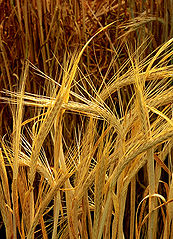Quickies
Zhenbin Hu et al., Population genomics of pearl millet (Pennisetum glaucum (L.) R. Br.): Comparative analysis of global accessions and Senegalese landraces. BMC genomics 2015. Open access → LINK [doi:10.1186/s12864-015-2255-0]
Abstract
Background
Pearl millet is a staple food for people in arid and semi-arid regions of Africa and South Asia due to its high drought tolerance and nutritional qualities. A better understanding of the genomic diversity and population structure of pearl millet germplasm is needed to support germplasm conservation and genetic improvement of this crop. Here we characterized two pearl millet diversity panels, (i) a set of global accessions from Africa, Asia, and the America, and (ii) a collection of landraces from multiple agro-ecological zones in Senegal.
Results
We identified 83,875 single nucleotide polymorphisms (SNPs) in 500 pearl millet accessions, comprised of 252 global accessions and 248 Senegalese landraces, using genotyping by sequencing (GBS) of PstI-MspI reduced representation libraries. We used these SNPs to characterize genomic diversity and population structure among the accessions. The Senegalese landraces had the highest levels of genetic diversity (π), while accessions from southern Africa and Asia showed lower diversity levels. Principal component analyses and ancestry estimation indicated clear population structure between the Senegalese landraces and the global accessions, and among countries in the global accessions. In contrast, little population structure was observed across in the Senegalese landraces collections. We ordered SNPs on the pearl millet genetic map and observed much faster linkage disequilibrium (LD) decay in Senegalese landraces compared to global accessions. A comparison of pearl millet GBS linkage map with the foxtail millet (Setaria italica) and sorghum (Sorghum bicolor) genomes indicated extensive regions of synteny, as well as some large-scale rearrangements in the pearl millet lineage.
Conclusions
We identified 83,875 SNPs as a genomic resource for pearl millet improvement. The high genetic diversity in Senegal relative to other regions of Africa and Asia supports a West African origin of this crop, followed by wide diffusion. The rapid LD decay and lack of confounding population structure along agro-ecological zones in Senegalese pearl millet will facilitate future association mapping studies. Comparative population genomics will provide insights into panicoid crop evolution and support improvement of these climate-resilient crops.
See also: Review of Tropical Neolithic flows (a most important agricultural development in the African and Asian Tropics).


.jpg/320px-Rice_Plants_(IRRI).jpg)




